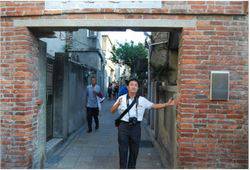Pass Door
What is a pass door? In order to maintain local security in the past, the pass doors were built on streets or inside alleys of Lukang. These doors were not only used for defense, but also for the divider of commercial streets. In the evening, all pass doors were closed to prevent robber invasion. In the early stage, when fighting with weapons happened, as long as people entered their pass doors, the enemy could not arbitrarily enter or make chase.
Extensively understanding the great people guardian.
 (Figure 1) All team members focused on listening to the explanation of the teacher.
(Figure 1) All team members focused on listening to the explanation of the teacher.
There were many pass doors in Lukang. There were three types according to their function: border pass door, alley pass door, and enclosed pass door. Them ajority of these were enclosed pass doors. They look old and plain, but it was a guardian of the people. Not only it can prevent robbers, but it can also prevent thieves from invasion. The pass door is 10 meters tall, and 8 meters wide. The lintel of the door is written with “waiting for the car to welcome people”. The position of the door hinge is on top of the lintel. There are big and small doors on a pass door. The big one has two door leaves while the small one has one leaf.
The architecture which cherish ancient wisdom
 (Figure 2) The teacher who works part-time as a historical site commentator in Lukang was introducing the pass door to us.
(Figure 2) The teacher who works part-time as a historical site commentator in Lukang was introducing the pass door to us.
There were around 60 pass doors in the early stage. Unfortunately, most of these were torn down due to the correction of streets, so only the one in Hou-che alley is left today, but it does not have big and small doors. This pass door owns the artistic values of being built hundred years ago, thick cultural flavor, and excellent design, so it was appraised as county historical site. Today, it is treated as a normal building for traffic purposes. We hope tourists can cherish our last pass door heritage.
Postscript
When the teacher told us that our next visit is a historical site, and was used to protect life and property of the Lukang people, I was very curious. We had many questions when we just got there, since the door looked so ordinary. After the teacher explained it in details, we admired the ancient people very much. If you want to learn more about ancient wise architecture, come to Lukang.

